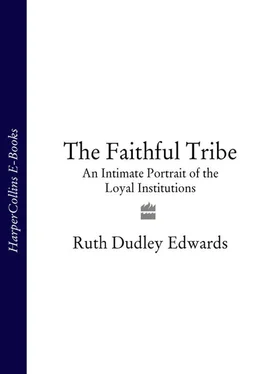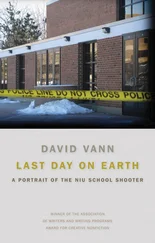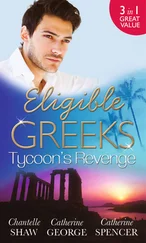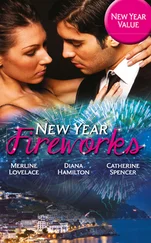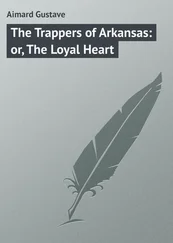The regalia that mean most to members of the loyal institutions, of course, are those handed down from father to son. ‘When I was eighteen, I joined my grandfather’s lodge,’ said one. ‘And my grandmother passed on his collarette, which had been his father’s collarette. I don’t wear his collarette now – it’s getting too old to wear. But it’s in a safe place and if my son wants to join I’ll pass it on to him.’
‘We treat our collarettes well, because they represent something important,’ said another, who has five from three different organizations. ‘It’s important to treat them with respect.’ (I saw a particularly graphic example of this at a parade where a group of Apprentice Boys could no longer contain themselves in the face of republican provocation. Before returning abuse and missiles, they took off their collarettes and put them in their pockets lest they dishonour them.)
District officers get to wear wider collars; county grand officers have silver fringes and Grand Lodge officers have gold fringes. Indications of office appear as, for instance, ‘WM’, ‘DM’, ‘S’, or ‘T’ (or even PWM for Past Worshipful Master) in front of the collarettes.
An Orangeman might wear no adornments on his collarette other than his lodge number and the insignia of his office, but many sport emblems and badges. (Apprentice Boys, being essentially secular, wear no emblems.) Emblems can be acquired rather on the charm-bracelet principle. The two most popular emblems are the self-explanatory CROWN and open BIBLE, which anyone can wear, as they can a representation of King William on his horse. Members of the Royal Arch Purple may also wear several others, including: an ANCHOR, symbolic of a safe arrival in the afterlife; the ARK OF THE COVENANT, ‘the visible evidence of God’s promise to be with and guide his people of Israel safely through life’; a COFFIN, as a reminder of mortality; an EYE, signifying God’s omniscience; a FIVE-POINTED STAR, a reminder of the five wounds of Christ; a LADDER, whose three steps represent Faith, Hope and Charity; NOAH’S ARK, the means by which God chose to save and regenerate life on earth, thus symbolizing ‘a better and purer life’; and a THREE-BRANCHED CANDLESTICK, symbolic of the light which is revealed by the Trinity of Father, Son and Holy Spirit.
The Royal Black Institution has many more again which relate to the institution and its degrees, and are biblical and have strong overtones of John Bunyan’s Pilgrim’s Progress. Among them are a BURNING BUSH; a LAMB, as in the Lamb of God; a little MAN WITH A BACKPACK, who represents a pilgrim, Joseph in Egypt; a RED HAND, a reference to the cloud no bigger than a man’s hand; a ROD WITH AN ENTWINED SNAKE, which harks back to Moses, whose rod became a snake and then changed back again; a SKULL AND CROSSBONES, which is the institution’s crest, representing mourning for Joseph when he was sold into slavery in Egypt and was given up for dead. The key emblem, however, is the RED CROSS which, since it represents the final degree, shows that you have taken all the others. It is red because Christ shed his blood, it is surrounded by a crown, because he was a king, but as with all Protestant crosses, it is empty, because Christ was resurrected.
Then there are badges or medals, which often relate to notable parades attended by the wearer, such as the Orange tercentenary celebration in Belfast, a Scottish Twelfth, a New Zealand jamboree or Drumcree 1995. ‘Some people stick a lot of rubbish on their collarettes,’ observed a senior Orangeman. ‘I hate that.’ Yet though like most of them he hates show, being by nature a squirrel, he has the largest private collection of badges, emblems and other memorabilia of any Orangeman I know. Most prized of all are service medals, sometimes those of a father or grandfather.
The banners
District, county and Grand Lodge officers are called upon to preside at many services and ceremonies, including the opening-up and closing-down of Orange Halls and the unfurling of new banners.
Banners are a great cause of both pride and worry to lodges. To the ordinary Orangeman, a banner sums up the spirit of his lodge. Although there is a fair amount of duplication of subjects, each banner is unique. Much deliberation will have gone into not just the choice of subject and artist, but the manner in which the lodge’s name and number will be presented and what colour and style and motifs should be used for the borders. The lodge member will know who painted it, where and when.
The downside is that banners are very vulnerable: after maybe a few dozen outings, batterings from wind and rain take a heavy toll. (They take a heavy toll on the standard-bearers too: in bad weather there is a constant battle just to keep the buffeted banner aloft, especially when its silk is weighed down by rain.) A lodge might have to requisition the painting of a new banner every ten years at a cost of maybe a thousand pounds. This will not only impose a financial burden which is serious for poor lodges, but may bring about disagreement between those of the brethren who want a new version of their old banner and those who want radical change.
As that student of parades Neil Jarman points out, while banners go back to the beginning of the Orange tradition, they developed extensively towards the end of the nineteenth century as unionism felt its identity under threat from Irish nationalism. ‘The banners became more standardized, more professional. The painting became of a better quality and the range of images expanded, so you moved away from the old images of a King Billy and the crown and the Bible to include a much greater range of heroes of Ulster unionism like Colonel Saunderson, later Carson, Craig. The elaboration of events from the Williamite wars and the massacre at the Bann in 1641 all appeared at those times along with biblical images which drew an analogy from the position of the Ulster Protestants to the Israelites in the biblical times.’
There is an enormous range of these large, colourful banners and they show pictorially the cultural reference points of the Protestant people. A major grievance in recent years was the BBC’s decision early in the 1980s to scrap television coverage of the Belfast Twelfth because, Orangemen think, of nationalist sensibilities. Even though in recent years there has been truncated coverage, what has been lost is the informed commentary on banners and bands that put the parade and the Orange Order in its historical and cultural context. These days, the media are interested in parades only if they provoke violence.
An Ulster Society survey identified thirteen categories of Orange banner. Many Orange and virtually all Black banners are BIBLICAL, the majority being Old Testament. The BUILDINGS represented are usually of local significance; most often they are churches. A typical example of the secular is Derrymore House, Bessbrook, carried by the local lodge because the Act of Union was signed there in 1800. The HOME RULE category depicts Ulster Protestantism in its most ‘no-surrender’ mode, with paintings of, for instance, the formation of the Ulster Volunteers. The HISTORICAL category covers events relating to the foundation of the Orange Order and the INDUSTRIAL particularly to the proud Belfast industrial past. Both WORLD WARS are there, the most moving image being that of the 36th Ulster Division, so many of whom were slaughtered at the Somme.
You have to be dead to be on a banner: popular PERSONALITIES are Winston Churchill, Oliver Cromwell and Sir James Craig, the long-serving prime minister of Northern Ireland: brethren murdered by the IRA during the TROUBLES sometimes become the subject of their lodge’s banner. Martin Luther is the reformer most often seen on REFORMATION banners and probably Queen Victoria among the ROYALTY; a very evocative banner in the latter category is that of the Great Northern True Blues, a Sandy Row railway employees’ lodge, showing a train festooned with union flags carrying King Edward VII to Belfast.
Читать дальше
